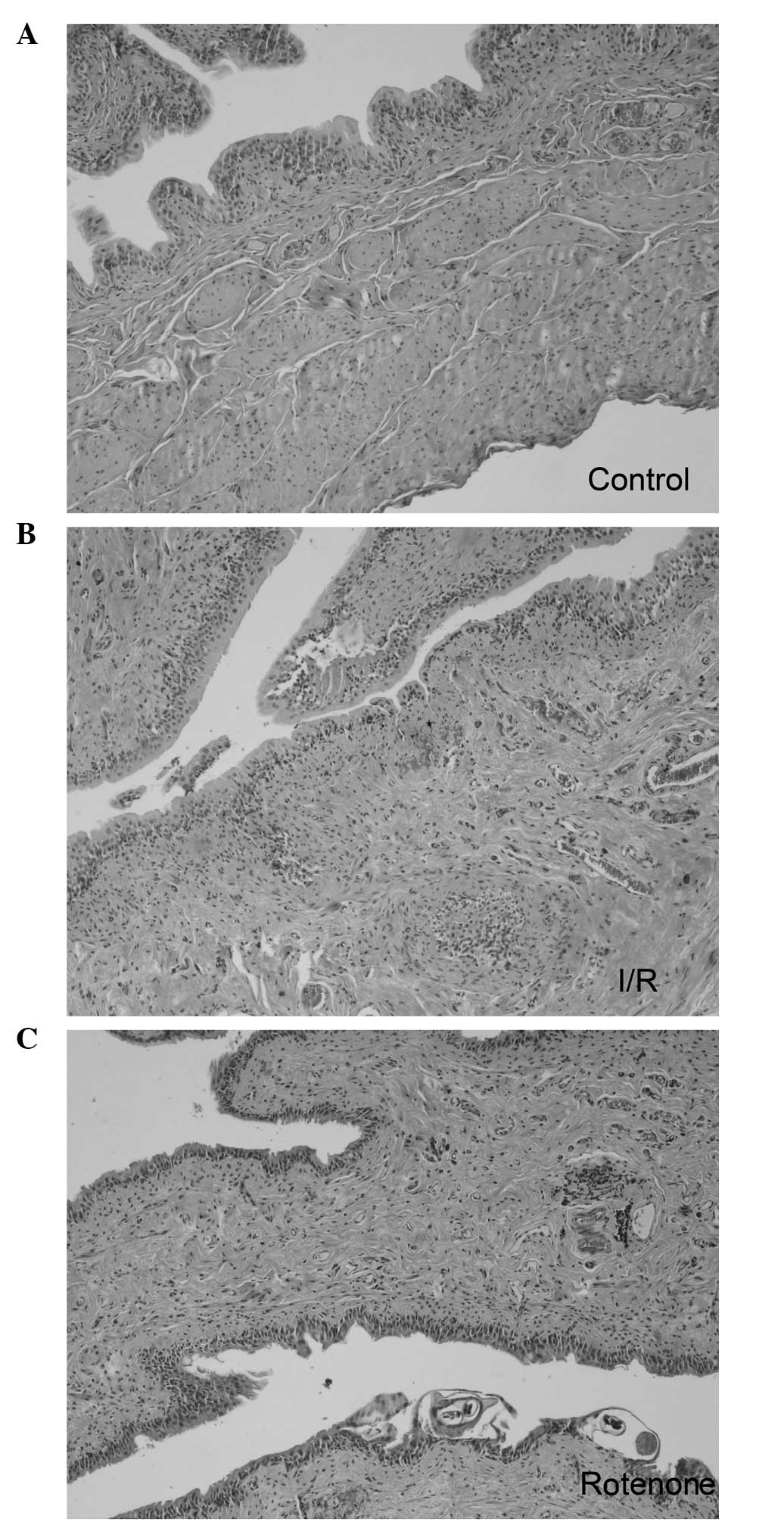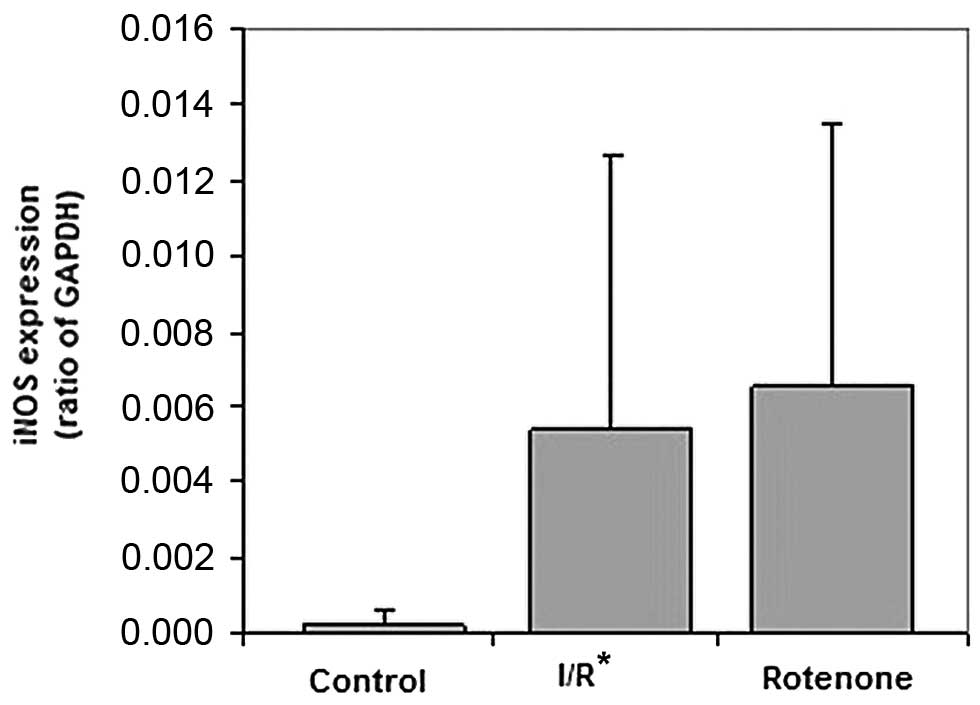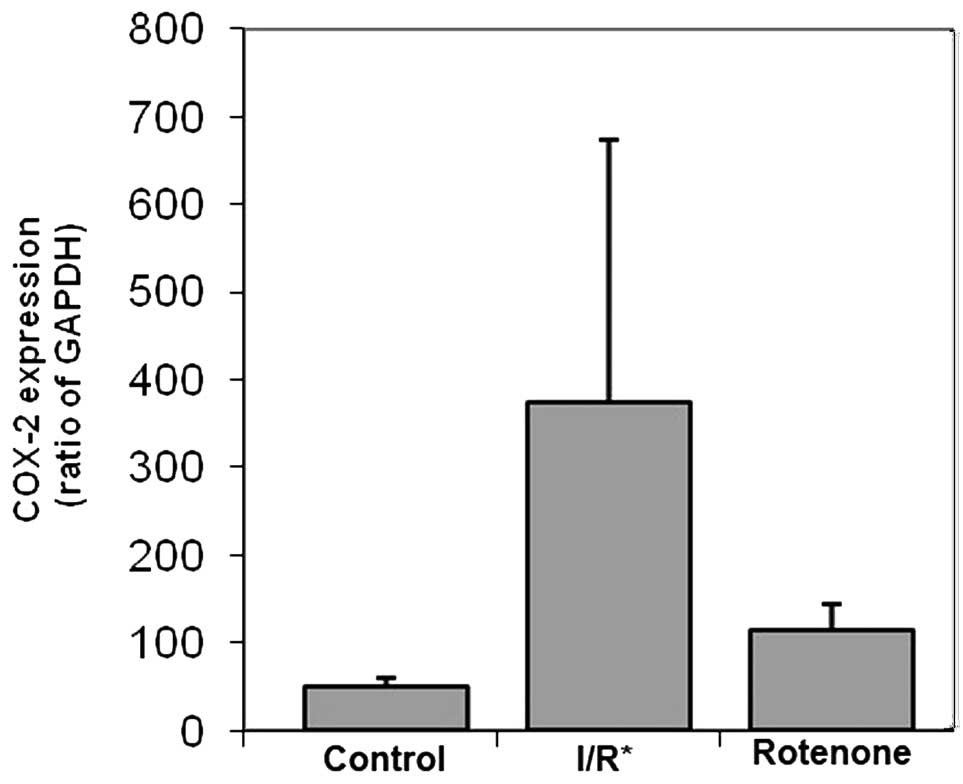|
1.
|
Viñas JL, Sola A, Genescà M, Alfaro V, Pí
F and Hotter G: NO and NOS isoforms in the development of apoptosis
in renal ischemia/reperfusion. Free Radic Biol Med. 40:992–1003.
2006.PubMed/NCBI
|
|
2.
|
Levin RM, Leggett R, Whitbeck C and Horan
P: Effect of calcium and calcium chelator on the response of the
bladder to in vitro ischaemia. Br J Urol. 82:882–887. 1998.
View Article : Google Scholar : PubMed/NCBI
|
|
3.
|
Ohnishi N, Liu SP, Horan P and Levin RM:
Effect of repetitive stimulation on the contractile response of
rabbit urinary bladder subjected to in vitro hypoxia or in vitro
ischemia followed by reoxygenation. Pharmacology. 57:139–147. 1998.
View Article : Google Scholar : PubMed/NCBI
|
|
4.
|
Wang JH, Chen HS, Wang T, Tian KL and Diao
YF: Role of oxygen-derived free radicals in superior mesenteric
artery occlusion shock in rats. Chin Med J (Engl). 103:278–282.
1990.PubMed/NCBI
|
|
5.
|
Lin AT, Chen KK, Yang CH and Chang LS:
Mannitol facilitates rabbit urinary bladder recovery from
overdistension injury. Urology. 56:702–707. 2000. View Article : Google Scholar : PubMed/NCBI
|
|
6.
|
Saito M and Miyagawa I: Bladder
dysfunction after acute urinary retention in rats. J Urol.
165:1745–1747. 2001. View Article : Google Scholar : PubMed/NCBI
|
|
7.
|
Greenland JE and Brading AF: Urinary
bladder blood flow changes during the micturition cycle in a
conscious pig model. J Urol. 156:1858–1861. 1996. View Article : Google Scholar : PubMed/NCBI
|
|
8.
|
Saito M and Miyagawa I:
N(G)-nitro-L-arginine methylester, a nitric oxide synthase
inhibitor, diminishes apoptosis induced by ischemia-reperfusion in
the rat bladder. Neurourol Urodyn. 21:566–571. 2002. View Article : Google Scholar
|
|
9.
|
Dupouy VM, Ferre PJ, Uro-Coste E and
Lefebvre HP: Time course of COX-1 and COX-2 expression during
ischemia-reperfusion in rat skeletal muscle. J Appl Physiol.
100:233–239. 2006. View Article : Google Scholar : PubMed/NCBI
|
|
10.
|
Conners W, Whitebeck C, Chicester P,
Legget L, Lin AD, Johnson A, Kogan B, Levin R and Mannikarottu A:
L-NAME, a nitric oxide synthase inhibitor, diminishes oxidative
damage in urinary bladder partial outlet obstruction. Am J Physiol
Renal Physiol. 290:357–363. 2006. View Article : Google Scholar : PubMed/NCBI
|
|
11.
|
Feldkamp T, Kribben A, Roeser NF, Senter
RA, Kemner S, Venkatachalam MA, Nissim I and Weinberg JM:
Preservation of complex I function during
hypoxia-reoxygenation-induced mitochondrial injury in proximal
tubules. Am J Physiol Renal Physiol. 286:F749–F759. 2004.
View Article : Google Scholar : PubMed/NCBI
|
|
12.
|
Sobajima S, Shimer AL, Chadderdon RC,
Kompel JF, Kim JS, Gilbertson LG and Kang JD: Quantitative analysis
of gene expression in a rabbit model of intervertebral disc
degeneration by real-time polymerase chain reaction. Spine J.
5:14–23. 2005. View Article : Google Scholar : PubMed/NCBI
|
|
13.
|
Gill HS, Monson FC, Wein AJ, Ruggieri MR
and Levin RM: The effects of short term in-vivo ischemia on the
contractile function of the rabbit urinary bladder. J Urol.
139:1350–1354. 1988.PubMed/NCBI
|
|
14.
|
Bratslavsky G, Kogan BA, Matsumoto S,
Aslan AR and Levin RM: Reperfusion injury of the rat bladder is
worse than ischemia. J Urol. 170:2086–2090. 2003. View Article : Google Scholar : PubMed/NCBI
|
|
15.
|
Ichikawa H, Takagi T, Uchiyama K,
Higashihara H, Katada K, Isozaki Y, Naito Y, Yoshida N and
Yoshikawa T: Rotenone, a mitochondrial electron transport
inhibitor, ameliorates ischemiareperfusion-induced intestinal
mucosal damage in rats. Redox Rep. 9:313–316. 2004. View Article : Google Scholar
|
|
16.
|
Vanden Hoek TL, Shao Z, Li C, Schumacker
PT and Becker LB: Mitochondrial electron transport can become a
significant source of oxidative injury in cardiomyocytes. J Mol
Cell Cardiol. 29:2441–2450. 1997.PubMed/NCBI
|
|
17.
|
Hiratsuka T, Futagami S, Tatsuguchi A, et
al: COX-1 and COX-2 conversely promote and suppress
ischemia-reperfusion gastric injury in mice. Scand J Gastroenterol.
40:903–913. 2005. View Article : Google Scholar : PubMed/NCBI
|
|
18.
|
Matsuyama M, Nakatani T, Hase T, et al:
The expression of cyclooxygenases and lipoxygenases in renal
ischemia-reperfusion injury. Transplant Proc. 36:1939–1942. 2004.
View Article : Google Scholar : PubMed/NCBI
|
|
19.
|
Tetsuka T, Baier LD and Morrison AR:
Antioxidants inhibit interleukin-1-induced cyclooxygenase and
nitric-oxide synthase expression in rat mesangial cells. Evidence
for post-transcriptional regulation. J Biol Chem. 271:11689–11693.
1996. View Article : Google Scholar
|

















